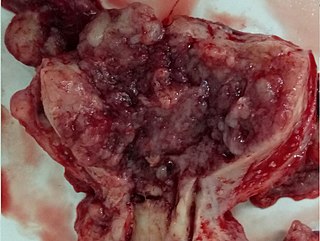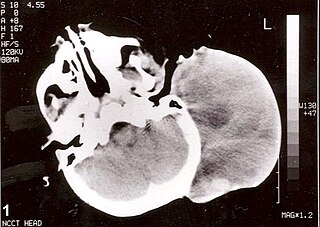Related Research Articles

A soft-tissue sarcoma(STS) is a malignant tumour, a type of cancer, that develops in soft tissue. A soft tissue sarcoma is often a painless mass that grows slowly over months or years. They may be superficial or deep-seated. Any such unexplained mass will need to be diagnosed by biopsy. Treatment may include, surgery, radiotherapy, chemotherapy, and targeted drug therapy. The other type of sarcoma is a bone sarcoma.

A sarcoma is a malignant tumor, a type of cancer that arises from transformed cells of mesenchymal origin. Connective tissue is a broad term that includes bone, cartilage, fat, vascular, or hematopoietic tissues, and sarcomas can arise in any of these types of tissues. As a result, there are many subtypes of sarcoma, which are classified based on the specific tissue and type of cell from which the tumor originates. Sarcomas are primary connective tissue tumors, meaning that they arise in connective tissues. This is in contrast to secondary connective tissue tumors, which occur when a cancer from elsewhere in the body spreads to the connective tissue. The word sarcoma is derived from the Greek σάρκωμα sarkōma "fleshy excrescence or substance", itself from σάρξ sarx meaning "flesh".

Uterine cancer, also known as womb cancer, are two types of cancer that develops from the tissues of the uterus. Endometrial cancer forms from the lining of the uterus and uterine sarcoma forms from the muscles or support tissue of the uterus. Symptoms of endometrial cancer include unusual vaginal bleeding or pain in the pelvis. Symptoms of uterine sarcoma include unusual vaginal bleeding or a mass in the vagina.

Rhabdomyosarcoma, or RMS, is an aggressive and highly malignant form of cancer that develops from skeletal (striated) muscle cells that have failed to fully differentiate. It is generally considered to be a disease of childhood, as the vast majority of cases occur in those below the age of 18. It is commonly described as one of the "small, round, blue cell tumours of childhood" due to its appearance on an H&E stain. Despite being a relatively rare cancer, it accounts for approximately 40% of all recorded soft tissue sarcomas.

Choriocarcinoma is a malignant, trophoblastic cancer, usually of the placenta. It is characterized by early hematogenous spread to the lungs. It belongs to the malignant end of the spectrum in gestational trophoblastic disease (GTD). It is also classified as a germ cell tumor and may arise in the testis or ovary.

Desmoplastic small-round-cell tumor (DSRCT) is an aggressive and rare cancer that primarily occurs as masses in the abdomen. Other areas affected may include the lymph nodes, the lining of the abdomen, diaphragm, spleen, liver, chest wall, skull, spinal cord, large intestine, small intestine, bladder, brain, lungs, testicles, ovaries, and the pelvis. Reported sites of metastatic spread include the liver, lungs, lymph nodes, brain, skull, and bones. It is characterized by the EWS-WT1 fusion protein.
The uterine sarcomas form a group of malignant tumors that arises from the smooth muscle or connective tissue of the uterus.
Vaginal cancer is a malignant tumor that forms in the tissues of the vagina. Primary tumors are most usually squamous cell carcinomas. Primary tumors are rare, and more usually vaginal cancer occurs as a secondary tumor. Vaginal cancer occurs more often in women over age 50, but can occur at any age, even in infancy. It often can be cured if found and treated in early stages. Surgery alone or surgery combined with pelvic radiation is typically used to treat vaginal cancer. Children can be diagnosed with advanced vaginal cancer. They are treated by surgery, radiation therapy, and chemotherapy. Vaginal cancer in children may recur. Gene therapy to treat vaginal cancer is currently in clinical trials.

Ewing's sarcoma is a type of cancer that may be a bone sarcoma or a soft-tissue sarcoma. Symptoms may include swelling and pain at the site of the tumor, fever, and a bone fracture. The most common areas where it begins are the legs, pelvis, and chest wall. In about 25% of cases, the cancer has already spread to other parts of the body at the time of diagnosis. Complications may include a pleural effusion or paraplegia.
Soft tissue sarcoma refer to a broad group of tumors that originate from connective tissues. They tend to have similar histologic appearance and biological behavior, and can be either benign or malignant. Soft tissue sarcomas can arise in any part of the pet's body but skin and subcutaneous tumors are the most commonly observed. Soft-tissue sarcomas comprise approximately 15% of all skin and subcutaneous tumors in dogs and approximately 7% of all skin and subcutaneous tumors in cats. The variety of different tumors that fall under the category of soft tissue sarcomas includes fibrosarcoma, hemangiopericytoma, liposarcoma, rhabdomyosarcoma, leiomyosarcoma, malignant fibrous histiocytoma, malignant nerve sheath tumors, myxosarcoma, myxofibrosarcoma, mesenchymoma, and spindle cell tumor.
Malignant ectomesenchymoma(MEM) is a rare, fast-growing tumor of the nervous system or soft tissue that occurs in children and young adults. MEM is part of a group of small round blue cell tumors which includes neuroblastoma, rhabdomyosarcoma, non-Hodgkin's lymphoma, and the Ewing's family of tumors.
Primary fallopian tube cancer (PFTC), often just tubal cancer, is a malignant neoplasm that originates from the fallopian tube.

Uterine serous carcinoma (USC), is an uncommon form of endometrial cancer that typically arises in postmenopausal women. It is typically diagnosed on endometrial biopsy, prompted by post-menopausal bleeding.
Neuroendocrine carcinoma of the cervix is best defined separately:Neuroendocrine: Of, relating to, or involving the interaction between the nervous system and the hormones of the endocrine glands.Carcinoma: An invasive malignant tumor derived from epithelial tissue that tends to metastasize to other areas of the body.

Endodermal sinus tumor (EST) is a member of the germ cell tumor group of cancers. It is the most common testicular tumor in children under 3, and is also known as infantile embryonal carcinoma. This age group has a very good prognosis. In contrast to the pure form typical of infants, adult endodermal sinus tumors are often found in combination with other kinds of germ cell tumor, particularly teratoma and embryonal carcinoma. While pure teratoma is usually benign, endodermal sinus tumor is malignant.
A rhabdomyoblast is a cell type which is essential to the diagnosis of a rhabdomyosarcoma. A rhabdomyoblast found histologically is considered diagnostic for embryonal, alveolar, and pleomorphic rhabdomyosarcomas. Histology will show an elongated or round cell, exhibiting an embryonic morphology. Occasionally cells will exhibit cross striations by light microscopy, reflecting sarcomere formation and advancement of differentiation. This differentiated phenotype increases following chemotherapy and radiotherapy.
Adenosarcoma is a rare malignant tumor that occurs in women of all age groups, but most commonly post-menopause. Adenosarcoma arises from mesenchymal tissue and has a mixture of the tumoral components of an adenoma, a tumor of epithelial origin, and a sarcoma, a tumor originating from connective tissue. The adenoma, or epithelial component of the tumor, is benign, while the sarcomatous stroma is malignant. The most common site of adenosarcoma formation is the uterus, but it can also occur in the cervix and ovaries. It more rarely arises in the vagina and fallopian tubes as well as primary pelvic or peritoneal sites, such as the omentum, especially in those with a history of endometriosis. The rare cases of adenosarcoma outside the female genital tract usually occur in the liver, bladder, kidney, as well as the intestine and are typically associated with endometriosis.
Lasers are used to treat cancer in several different ways. Their high-intensity light can be used to shrink or destroy tumors or precancerous growths. Lasers are most commonly used to treat superficial cancers such as basal-cell skin cancer and the very early stages of some cancers, such as cervical, penile, vaginal, vulvar, and non-small cell lung cancer.
Vulvar tumors are those neoplasms of the vulva. Vulvar and vaginal neoplasms make up a small percentage (3%) of female genital cancers. They can be benign or malignant. Vulvar neoplasms are divided into cystic or solid lesions and other mixed types. Vulvar cancers are those malignant neoplasms that originate from vulvar epithelium, while vulvar sarcomas develop from non-epithelial cells such as bone, cartilage, fat, muscle, blood vessels, or other connective or supportive tissue. Epithelial and mesenchymal tissue are the origin of vulvar tumors.
References
- ↑ " botryoid sarcoma " at Dorland's Medical Dictionary
- ↑ Rahaman, J and Cohen, CJ. Gynecologic Sarcomas. in Holland-Frei Cancer Medicine - 6th Ed. Kufe, DW et al. editors. BC Decker Inc., Hamilton, Ontario, 2003.
- ↑ Piver M, Rose P (1988). "Long-term follow-up and complications of infants with vulvovaginal embryonal rhabdomyosarcoma treated with surgery, radiation therapy, and chemotherapy". Obstet Gynecol. 71 (3 Pt 2): 435–7. PMID 3347430.
- ↑ Rotmensch, J and Yamada, SD. Neoplasms of the Vulva and Vagina. in Holland-Frei Cancer Medicine - 6th Ed. Kufe, DW et al. editors. BC Decker Inc., Hamilton, Ontario, 2003.
- ↑ Hilgers R (1975). "Pelvic exenteration for vaginal embryonal rhabdomyosarcoma: a review". Obstet Gynecol. 45 (2): 175–80. PMID 1090863.
- ↑ Reynolds E, Logani S, Moller K, Horowitz I (2006). "Embryonal rhabdomyosarcoma of the uterus in a postmenopausal woman. Case report and review of the literature". Gynecol Oncol. 103 (2): 736–9. doi:10.1016/j.ygyno.2006.03.033. PMID 16684558.